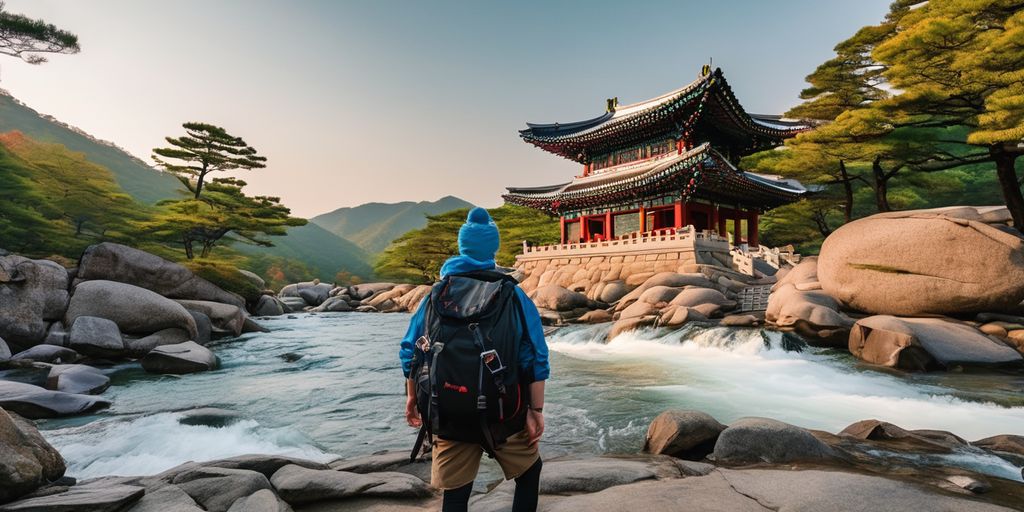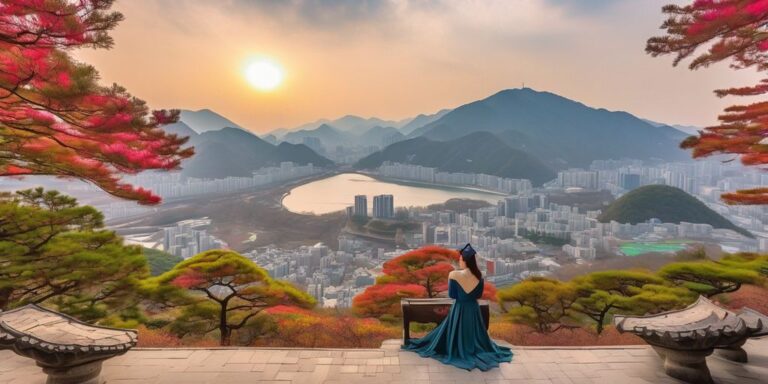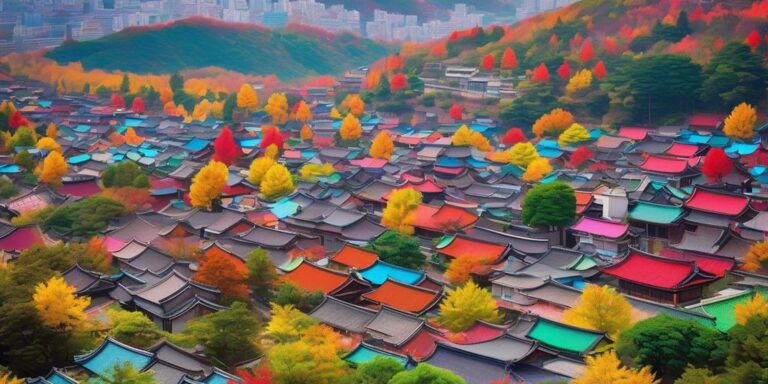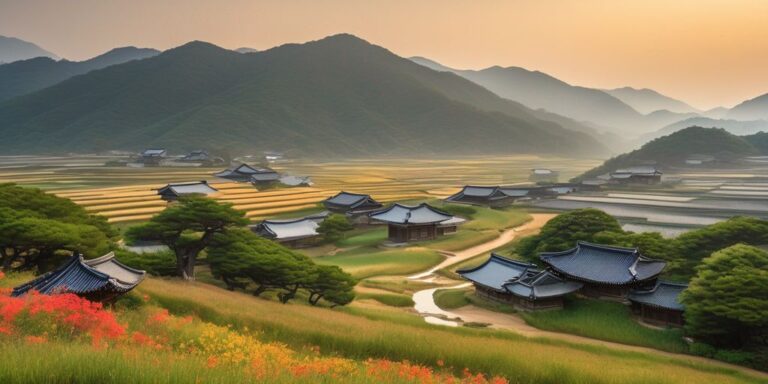
Embark on a thrilling backpacking journey through South Korea, from the bustling streets of Seoul to the serene landscapes of Jeju Island. This article, ‘Korea Escapade: A Backpacker’s Adventure’, is designed to guide and inspire adventurers seeking to explore the rich culture, natural beauty, and vibrant urban life of Korea. Discover essential tips, hidden gems, and exciting activities that will make your Korean backpacking experience unforgettable.
Key Takeaways
- Explore diverse regions from urban Seoul to rural Gyeongsang-do, each offering unique experiences.
- Utilize local transport and couchsurfing to immerse yourself in Korean culture and save on costs.
- Enjoy the natural wonders of Jeju Island and the cultural festivities across the country.
- Learn practical tips for navigating language barriers and managing your travel budget effectively.
- Capture the essence of Korean cuisine through street food and local markets.
Embarking on the Journey: First Impressions and Arrivals
Touchdown and First Steps
Upon arrival, the immaculate condition of the airport and its surroundings immediately stood out. The facilities were not only well-maintained but also showcased a high level of organization, making the first steps of the journey smooth and welcoming.
Navigating Local Transport
Navigating through Seoul’s transport system was an adventure in itself. From the extensive subway network to the efficient bus services, getting around was surprisingly straightforward. Here’s a quick guide to help you:
- Subway: The fastest way to traverse the city, with clear English signs.
- Buses: Connects broader areas not covered by the subway.
- Taxis: Readily available but relatively more expensive.
Initial Cultural Encounters
The initial cultural encounters were fascinating, offering a glimpse into the daily life and customs of the locals. From the respectful bowing in greetings to the vibrant street markets, every interaction was a learning experience. The warmth and hospitality of the people made these encounters even more memorable.
Exploring Seoul: The Urban Heartbeat
Historic Sites and Modern Skyscrapers
Seoul, a city where history meets modernity, offers an array of breathtaking historic sites alongside towering skyscrapers. Explore the majestic Gyeongbokgung Palace, then marvel at the modern architecture of the N Seoul Tower. This juxtaposition defines Seoul’s unique urban landscape.
Street Food and Local Delicacies
Seoul’s streets are a paradise for food lovers. From sizzling street food to traditional Korean home cooking essentials like Bibimbap and chigae (stews), every corner offers a taste of local flavors. Sampling street food is an absolute must for a genuine Seoul experience.
Nightlife and Shopping Districts
Seoul’s vibrant nightlife and extensive shopping districts are not to be missed. Dive into the lively atmosphere of districts like Myeongdong for a shopping spree or experience the bustling nightlife in areas such as Hongdae. The city comes alive at night, offering endless entertainment and shopping options.
The Natural Wonders of Jeju Island
Volcanic Landscapes and Lush Greenery
Jeju Island, a UNESCO World Heritage Site, is renowned for its volcanic landscapes and lush greenery. Visitors can explore the majestic Hallasan Mountain, the highest in South Korea, and the intriguing Manjanggul Cave. The island’s natural beauty is a magnet for both nature lovers and photographers seeking to capture its breathtaking views.
Beaches and Coastal Adventures
The island’s coastline offers a plethora of activities from swimming in crystal clear waters to exploring hidden coves. Jeju’s beaches are perfect for those looking to relax or engage in water sports. The clean air and vibrant marine life make it an ideal spot for snorkeling and diving.
Local Folk Villages and Culture
Jeju is not only about natural beauty but also rich in cultural heritage. The local folk villages provide a glimpse into the island’s traditional life. Visitors can experience the local customs and practices that have been preserved over generations. This cultural immersion adds a unique layer to the exploration of the island.
Cultural Immersion: Festivals and Local Customs
Traditional Festivals and Celebrations
Korea’s calendar brims with festivals that offer a deep dive into the country’s rich traditions and vibrant cultural tapestry. From the colorful Seollal (Korean New Year) to the serene rituals of Chuseok (Korean Thanksgiving), each festival is a doorway to understanding the communal spirit and heritage of Korea. Notably, the government has selected three local festivals — Incheon Pentaport Rock Festival, Suwon Hwaseong Cultural Festival, and Hwacheon Sancheoneo Ice Festival — to foster into global tourism events.
The Art of Korean Cuisine
Exploring Korean cuisine is akin to exploring its culture. Each region presents a unique flavor profile, from the spicy dishes of Jeolla to the fresh seafood of Gangwon. Cooking classes and food tours are popular ways to immerse oneself in the culinary arts of Korea, offering hands-on experience with dishes like kimchi making and bibimbap assembly.
Learning Through Local Interaction
Engaging with locals provides invaluable insights into Korean customs and daily life. Participating in a village hanok stay or joining in a local festival can lead to meaningful exchanges and a deeper appreciation of Korea’s community-focused culture. Blockquote: > Embrace the opportunity to learn directly from the artisans and elders who embody the living history and traditions of their regions.
Off the Beaten Path: Underrated Sights of Gyeongsang-do
Hidden Gems and Secret Locales
Gyeongsang-do, a province rich in history and natural beauty, offers a plethora of hidden gems and secret locales that are often overshadowed by the more popular destinations in South Korea. From the serene landscapes of Haeinsa Temple to the bustling traditional markets in Daegu, each site offers a unique glimpse into the region’s rich cultural tapestry. Exploring these hidden spots provides a deeper understanding of Korea’s heritage and natural beauty.
Cultural Heritage Sites
This region is home to some of South Korea’s most significant cultural heritage sites. The ancient city of Gyeongju, known as the ‘museum without walls’, boasts relics like Bulguksa Temple and Seokguram Grotto. These sites not only offer a journey back in time but also provide insights into the spiritual and architectural prowess of ancient Korea.
Local Markets and Artisan Crafts
Gyeongsang-do’s local markets and artisan crafts are a testament to the region’s vibrant culture and economy. Markets such as the Jinju Lantern Festival provide a colorful display of local artistry and craftsmanship. Visitors can immerse themselves in the local culture by engaging with artisans and sampling traditional Korean delicacies. This hands-on experience is invaluable for those looking to understand and appreciate the local way of life.
Adventures in the Korean Countryside
Hiking and Outdoor Activities
Korea’s countryside offers a plethora of hiking opportunities that cater to all levels of experience. From the serene trails of Seoraksan to the challenging ascents of Bukhansan, each hike promises breathtaking views and a chance to connect with nature. Hiking is not just a physical activity but a social one too, often involving large groups dressed in the latest outdoor fashion.
Rural Homestays and Farming Life
Experience the authentic Korean rural life through homestays and farming activities. Engage in daily tasks such as planting rice or harvesting vegetables. This hands-on approach provides a deeper understanding of the local culture and lifestyle. It’s an opportunity to live like a local and enjoy the hospitality of Korean countryside residents.
Scenic Villages and Historical Towns
Explore the hidden gems of Korea’s countryside, where historical towns and scenic villages offer a glimpse into the country’s rich heritage. Wander through narrow lanes lined with traditional houses, and discover local markets bustling with activity. These villages are not just relics of the past but are vibrant communities with unique stories to tell.
Tips and Tricks for the Savvy Backpacker
Packing Essentials for Korea
Pack light but smartly for your Korean adventure. Essentials include comfortable walking shoes, a versatile jacket for varying weather, and a power adapter compatible with Korean outlets. Consider packing a portable Wi-Fi device to stay connected and a waterproof bag for unexpected rain.
Navigating Language Barriers
While English is spoken in major tourist areas, learning a few basic Korean phrases can greatly enhance your experience. Carry a translation app or a small phrasebook. Interactions with locals will be smoother and more enjoyable.
Budgeting and Money-Saving Hacks
To manage your travel budget effectively, use local transportation options like buses and subways, which are cheaper than taxis. Eating at local markets can also save money while offering a taste of authentic Korean cuisine. For accommodation, explore options like guesthouses or hostels, which often provide the best value.
Conclusion
Reflecting on my backpacking journey through Korea, it’s clear that this adventure was more than just a trip—it was a profound exploration of culture, nature, and self-discovery. From the bustling streets of Seoul to the serene landscapes of Gangwondo, each moment was a new chapter in a story filled with unexpected friendships, culinary delights, and personal growth. Korea, with its rich history and vibrant modernity, offered an unparalleled backdrop for this unforgettable escapade. For those yearning for adventure and stories to tell, Korea is a destination that truly delivers on all fronts.
Frequently Asked Questions
What is the best time to visit South Korea for a backpacking trip?
Autumn is highly recommended as the weather is cool and pleasant, perfect for outdoor activities and exploring the cities.
Can you recommend any budget-friendly accommodations in South Korea?
Consider couchsurfing to immerse yourself with locals or check platforms like HostelBookers and HostelWorld for affordable backpacker accommodations.
What are some must-visit places in South Korea for a first-time backpacker?
Don’t miss exploring Seoul’s historic sites and modern skyscrapers, the natural wonders of Jeju Island, and the cultural experiences in Gyeongsang-do.
What are some tips for navigating language barriers in South Korea?
Learning basic Korean phrases can be helpful. Also, utilizing translation apps and carrying a phrasebook can ease communication challenges.
How can I experience authentic Korean culture during my trip?
Engage in local festivals, try traditional Korean cuisine, and interact with locals through activities like rural homestays or market visits.
Are there any specific customs or etiquette I should be aware of while backpacking in South Korea?
Respect local customs such as removing shoes before entering homes, bowing as a greeting, and using two hands when receiving or giving items, especially to elders.




Leave a Comment